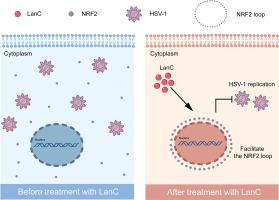Phytomedicine ( IF 6.7 ) Pub Date : 2023-12-25 , DOI: 10.1016/j.phymed.2023.155308 Songbin Wu 1 , Sashuang Wang 2 , Xiaomian Lin 3 , Shaomin Yang 1 , Xiyuan Ba 1 , Donglin Xiong 1 , Lizu Xiao 1 , Rongzhen Li 1

|
Background
In the past decades, extensive research has been conducted to identify new drug targets for the treatment of Herpes simplex virus type 1 (HSV-1) infections. However, the emergence of drug-resistant HSV-1 strains remains a major challenge. This necessitates the identification of new drugs with novel mechanisms of action. Lanatoside C (LanC), a cardiac glycoside (CG) approved by the US Food and Drug Administration (FDA), has demonstrated anticancer and antiviral properties. Nevertheless, its potential as an agent against HSV-1 infections and the underlying mechanism of action are currently unknown.
Purpose
This study aimed to investigate the antiviral activity of LanC against HSV-1 and elucidate its molecular mechanisms.
Methods
The in vitro antiviral activity of LanC was assessed by examining the levels of viral genes, proteins, and virus titers in HSV-1-infected ARPE-19 and Vero cells. Immunofluorescence (IF) analysis was performed to determine the intracellular distribution of NRF2. Additionally, an in vivo mouse model of HSV-1 infection was developed to evaluate the antiviral activity of LanC, using indicators such as intraepidermal nerve fibers (IENFs) loss and viral gene inhibition.
Results
Our findings demonstrate that LanC significantly inhibits HSV-1 replication both in vitro and in vivo. The antiviral effect of LanC is mediated by the perinuclear translocation of NRF2.
Conclusions
LanC exhibits anti-HSV-1 effects in viral infections, which are associated with the intracellular translocation of NRF2. These findings suggest that LanC has the potential to serve as a novel NRF2 modulator in the treatment of viral diseases.
中文翻译:

Lanatoside C 通过调节细胞内 NRF2 分布抑制单纯疱疹病毒 1 复制
背景
在过去的几十年里,人们进行了大量的研究来确定治疗 1 型单纯疱疹病毒 (HSV-1) 感染的新药物靶点。然而,耐药 HSV-1 菌株的出现仍然是一个重大挑战。这就需要鉴定具有新作用机制的新药。 Lanatoside C (LanC) 是一种经美国食品和药物管理局 (FDA) 批准的强心苷 (CG),已被证明具有抗癌和抗病毒特性。然而,其作为抗 HSV-1 感染药物的潜力及其潜在作用机制目前尚不清楚。
目的
本研究旨在探讨LanC对HSV-1的抗病毒活性并阐明其分子机制。
方法
LanC 的体外抗病毒活性通过检查 HSV-1 感染的 ARPE-19 和 Vero 细胞中的病毒基因、蛋白质和病毒滴度水平进行评估。进行免疫荧光(IF)分析以确定NRF2的细胞内分布。此外,还开发了 HSV-1 感染的体内小鼠模型,以使用表皮内神经纤维 (IENF) 损失和病毒基因抑制等指标来评估 LanC 的抗病毒活性。
结果
我们的研究结果表明 LanC在体外和体内均显着抑制 HSV-1 复制。 LanC 的抗病毒作用是由 NRF2 的核周易位介导的。
结论
LanC 在病毒感染中表现出抗 HSV-1 作用,这与 NRF2 的细胞内易位有关。这些发现表明 LanC 有潜力作为一种新型 NRF2 调节剂来治疗病毒性疾病。






























 京公网安备 11010802027423号
京公网安备 11010802027423号